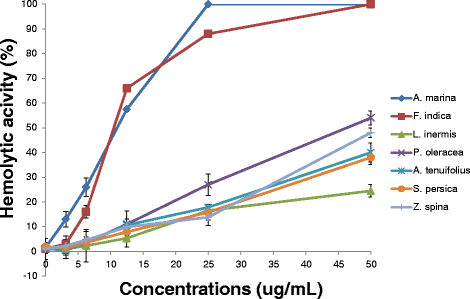Assessment of herbal drugs for promising anti-Candida activity
- PMID: 28482836
- PMCID: PMC5422888
- DOI: 10.1186/s12906-017-1760-x
Assessment of herbal drugs for promising anti-Candida activity
Abstract
Background: Microbial infections are diverse and cause serious human diseases. Candida albicans infections are serious healthcare-related infections that are complicated by its morphological switching from yeast to hyphae, resistant biofilm formation and mixed infections with bacteria. Due to the increase in drug resistance to currently used antimicrobial agents and the presence of undesirable side effects, the need for safe and effective novel therapies is important. Compounds derived from plants are known for their medicinal properties including antimicrobial activities. The purpose of the study was to compare and evaluate the anti-Candida activities of several medicinal plants in order for the selection of a herbal drug for human use as effective antimicrobial. The selection was taking into considerations two important parameters; parameters related to the selected drug including activity, stability, solubility and toxicity and parameters related to the pathogen including its different dynamic growth and its accompanied secondary bacterial infections.
Methods: Seven different plants including Avicennia marina (Qurm), Fagonia indica (Shoka'a), Lawsania inermis (Henna), Portulaca oleracea (Baq'lah), Salvadora persica (Souwak), Ziziphus spina- Christi (Sidr) and Asphodelus tenuifolius (Kufer) were ground and extracted with ethanol. The ethanol extracts were evaporated and the residual extract dissolved in water prior to testing against Candida albicans in its different morphologies. The antibacterial and cytotoxic effects of the plants extracts were also tested.
Results: Out of the seven tested plants, L. inermis and P. oleracea showed significant anti-Candida activity with MIC ~10 μg/mL. Furthermore, both plant extracts were able to inhibit C. albicans growth at its dynamic growth phases including biofilm formation and age resistance. Accompanied secondary bacterial infections can complicate Candida pathogenesis. L. inermis and P. oleracea extracts showed effective antibacterial activities against S. aureus, P. aeruginosa, E. coli, and the multidrug resistant (MDR) A. baumannii and Klebsiella pneumoniae. Both extracts showed no toxicity when measured at their MIC on human erythrocytes.
Conclusion: The results from this study suggested that L. inermis and P. oleracea extracts and/or their chemicals are likely to be promising drugs for human use against C. albicans and MDR bacteria.
Keywords: Activity; Antimicrobial; Biofilm; Candida albicans; Medicinal plant; Toxicity.
Figures


References
-
- Inghammar M, Engström G, Ljungberg B, Löfdahl C-G, Roth A, Egesten A. Increased incidence of invasive bacterial disease in chronic obstructive pulmonary disease compared to the general population-a population based cohort study. BMC Infect Dis. 2014;14(1):163. doi: 10.1186/1471-2334-14-163. - DOI - PMC - PubMed
-
- Spellberg B, Guidos R, Gilbert D, Bradley J, Boucher HW, Scheld WM, Bartlett JG, Edwards J. America tIDSo. The epidemic of antibiotic-resistant infections: A call to action for the medical community from the infectious diseases society of America. Clin Infect Dis. 2008;46(2):155–164. doi: 10.1086/524891. - DOI - PubMed
-
- Poulin M-C, Villeneuve J. Drug Shortages: A public health issue that demands a coordinated response. Recommendations of the working committee on drug shortages. Québec: Ordre des pharmaciens du Québec; 2012.
MeSH terms
Substances
Grants and funding
LinkOut - more resources
Full Text Sources
Other Literature Sources

